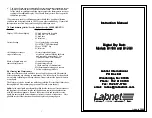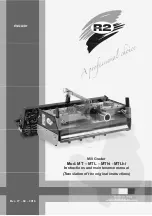
Setting up the unit
To activate the unit, connect the included power supply to the unit and a suitable 230V, 50 Hz power outlet.
The fixture will start up and show the last chosen setting on the display. Usually, with a new product, this is
the DMX mode with the value set on 001.
The display shows several settings, each with the possibility to set several values.
Use the display and the menu buttons to set preferences, change settings and scroll through the menu.
“Enter” is used to save a certain setting or preset, press “Menu” for at least 2 seconds to discard the change
and return to the main menu.
The table below shows an explanation for every feature and value.
display
Mode
Function
ADDR
DMX address setting
A001-A512
CHND
Channel mode
1CH/3CH/10CH
SLND
Master/slave mode
Master (default)
Slave 1 - Slave 2
SHND
Show mode
SH0 – SH08 – Auto speed 1-9
SOUN
Sound controlled mode
Sound controlled mode on/off
BLND
Black out mode
LED mode, YES- NO
Led
LED mode
ON-OFF
DISP
Display inversion
Display Inversion, Idsp-dspI
TEST
Test mode
Self test
FHRS
Using time of light
Fixture hours,0 ~ 9999
REST
Reset function
Test functions and reset
ADDR:
DMX address setting, used to determine the DMX starting channel. From this channel on, the fixture
will respond to values, corresponding with the amount of channels that the fixture is occupying. (For
example, when set the starting address to value 003, the fixture will respond from channels 3, 4, 5 etc..)
CHND:
The channel mode of the fixture makes it possible to use the correct channel mode setting for every
application. For simple and basic setups, users may prefer to use the 1- or 3-channel mode. For advanced
setup, users may prefer to control each pixel in detail, by using the 15- or 18-channel mode.
SLND:
When using the master/slave function, you need to connect 2 or more fixtures with XLR-XLR cable.
The first fixture in line needs to be set as master, the others as Slave 1 or 2 (synchronized or mirrored
performance). This way, the slaves will mimic the behavior of the master fixture for wonderful synchronized
lighting shows.
SHND:
Show mode uses the internal programs of the fixture to perform a self-performing light show. Select
one of the internal programs and set the speed to the desired value.
SOUN:
Activate or disable the built-in sound controlled mode. This way, the fixture will respond to the beat of
the music.
SENE:
The sensitivity of the built-in microphone is adjustable, to optimize the built-in sound controlled mode.
For example, when your music source (speakers) are placed far away, you might want to increase the
sensitivity to make sure that the fixture responds to the sound accurately.
Led:
The LED display will shut off automatically after a few seconds when this function is activated. When
pressing any button, the display will activate again. When deactivating the feature, the display will be lit
permanently.
DISP:
Display invert version – When using the fixture in a hanging setup, it is possible to flip the display, so
the characters will be shown upside down. This makes reading the several statuses much easier.
TEST:
Self test mode, to control all segments and LEDs



























